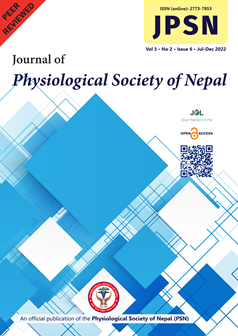Computer Vision Syndrome among Undergraduate Medical Students of Nepal: A Cross-sectional Study
DOI:
https://doi.org/10.3126/jpsn.v3i2.65284Keywords:
Digital devices, medical students, Nepal, ocular symptoms, syndromeAbstract
Background : Prolonged computer use can lead to Computer Vision Syndrome (CVS), a group of symptoms that affects work efficiency and productivity. Medical students are at high risk for CVS. This study aimed to assess the frequency of CVS among undergraduate medical students in Nepal.
Methods : A descriptive cross-sectional study was conducted among 190 first and second-year medical students at Nepalgunj Medical College. Data were collected using a semi-structured questionnaire and analyzed using descriptive and analytical statistics.
Results : Among 190 participants, most (86.3%) reported symptoms of CVS, with headache (49.5%) and neck/shoulder pain (47%) being the most common, and double vision (3.7%) the least common ones. Blue filters (51.6%) and correction glasses (49.5%) were the most common preventive measures, while only 15.8% of students followed the 20/20/20 rule. Female students had higher rates of refractive errors (p=0.016) and headache (p=0.041), but lower rates of redness (p=0.019), compared to males. Symptoms were significantly associated with longer duration of device use (p<0.001).
Conclusion : CVS is prevalent among medical students and was related to device use habits. Increased awareness of the effects of computer use and its preventive measures is needed in medical colleges.
Downloads
Downloads
Published
How to Cite
Issue
Section
License
Copyright (c) 2024 Journal of Physiological Society of Nepal

This work is licensed under a Creative Commons Attribution-NonCommercial 4.0 International License.

